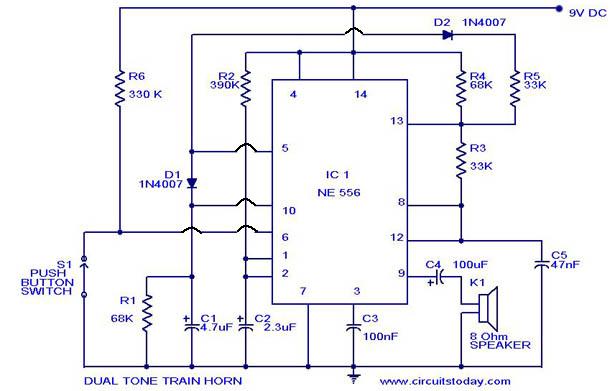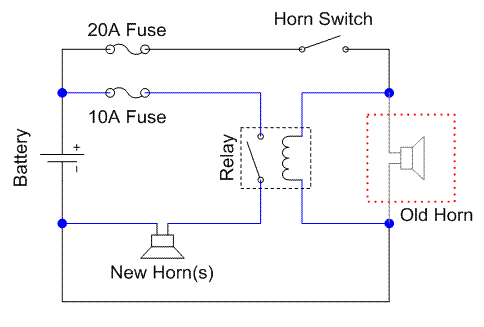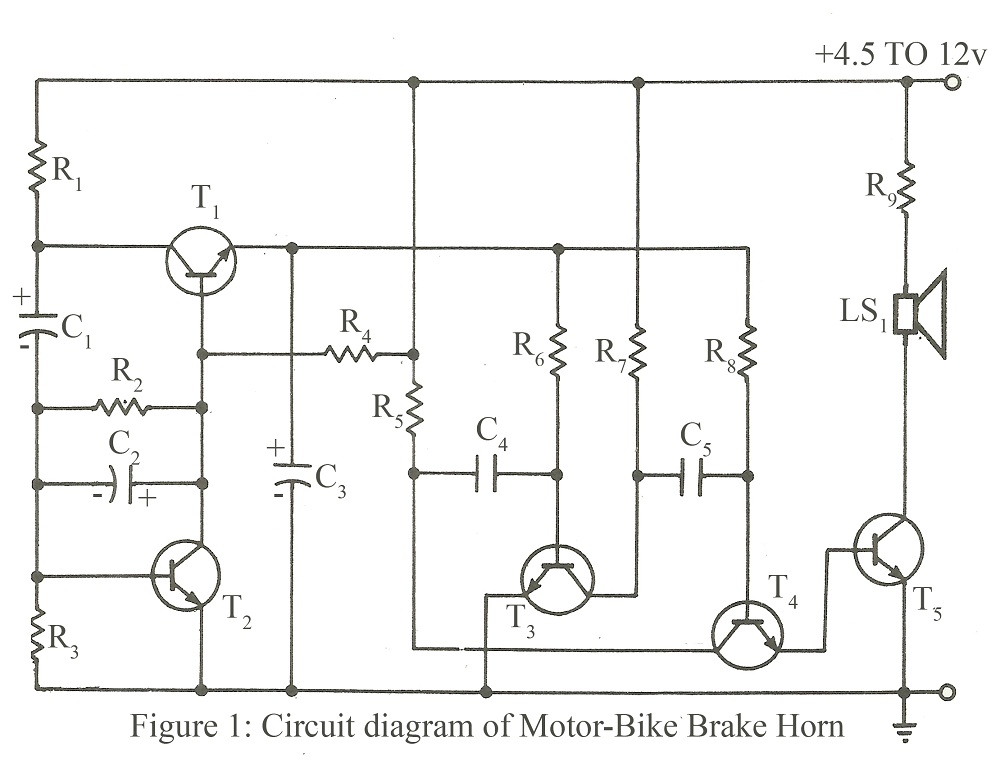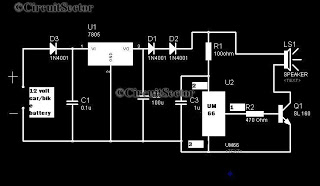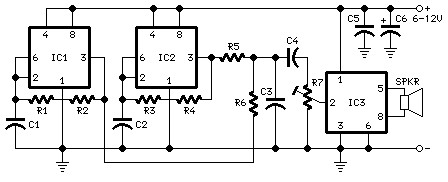
HORN CIRCUIT_FOR_MOTORCYCLE_USE

Gates U1-a and U1-b of the 4093 quad 2-input NAND Schmitt trigger are connected in variable, low-frequency square-wave oscillator circuits. The output of gate U1-a is connected to one of the inputs of gate U1-b. The square-wave output of gate U1-a modulates oscillator U1-b, producing a two-tone output. A really interesting sound can be produced by careful adjustments.
The described circuit employs two gates from the 4093 quad 2-input NAND Schmitt trigger to create a variable low-frequency square-wave oscillator. The configuration leverages the inherent hysteresis of the Schmitt trigger, which provides stable switching characteristics, allowing for the generation of clean square waves even at low frequencies.
In this setup, the output of gate U1-a is fed back to one of the inputs of gate U1-b. This feedback loop is crucial as it allows gate U1-a to trigger gate U1-b, resulting in a modulation effect that produces a two-tone output. The frequency of oscillation can be adjusted by varying the resistor and capacitor values connected to the gates. Typically, a capacitor is connected between the output of gate U1-a and the ground, while resistors are connected to the inputs of both gates to set the timing characteristics.
The unique aspect of this configuration is the interaction between the two gates, which can create complex waveforms when the circuit parameters are fine-tuned. By adjusting the resistor values or the capacitor size, the frequency and duty cycle of the output waveform can be altered, leading to a variety of interesting audio outputs. This circuit can be particularly useful in sound synthesis applications, where unique tonal qualities are desired. The resulting two-tone output can be further processed with additional circuitry for effects or amplification, enhancing its applicability in electronic music production or sound design.Gates U1-a and U1-b of the 4093 quad 2-tnput NAND Schmitt trigger are connected in variable, low-frequency, square-wave oscillator circuits. The output of gate U1-a is connected to one of the inputs of gate U1-b. The square-wave output of gate U1-a modulates oscillator U1-b, producing a two-tone output. A really interesting sound can be producecl by carefu.. 🔗 External reference
The described circuit employs two gates from the 4093 quad 2-input NAND Schmitt trigger to create a variable low-frequency square-wave oscillator. The configuration leverages the inherent hysteresis of the Schmitt trigger, which provides stable switching characteristics, allowing for the generation of clean square waves even at low frequencies.
In this setup, the output of gate U1-a is fed back to one of the inputs of gate U1-b. This feedback loop is crucial as it allows gate U1-a to trigger gate U1-b, resulting in a modulation effect that produces a two-tone output. The frequency of oscillation can be adjusted by varying the resistor and capacitor values connected to the gates. Typically, a capacitor is connected between the output of gate U1-a and the ground, while resistors are connected to the inputs of both gates to set the timing characteristics.
The unique aspect of this configuration is the interaction between the two gates, which can create complex waveforms when the circuit parameters are fine-tuned. By adjusting the resistor values or the capacitor size, the frequency and duty cycle of the output waveform can be altered, leading to a variety of interesting audio outputs. This circuit can be particularly useful in sound synthesis applications, where unique tonal qualities are desired. The resulting two-tone output can be further processed with additional circuitry for effects or amplification, enhancing its applicability in electronic music production or sound design.Gates U1-a and U1-b of the 4093 quad 2-tnput NAND Schmitt trigger are connected in variable, low-frequency, square-wave oscillator circuits. The output of gate U1-a is connected to one of the inputs of gate U1-b. The square-wave output of gate U1-a modulates oscillator U1-b, producing a two-tone output. A really interesting sound can be producecl by carefu.. 🔗 External reference
